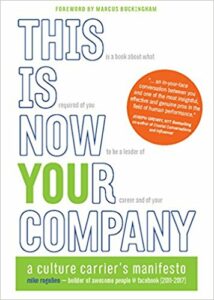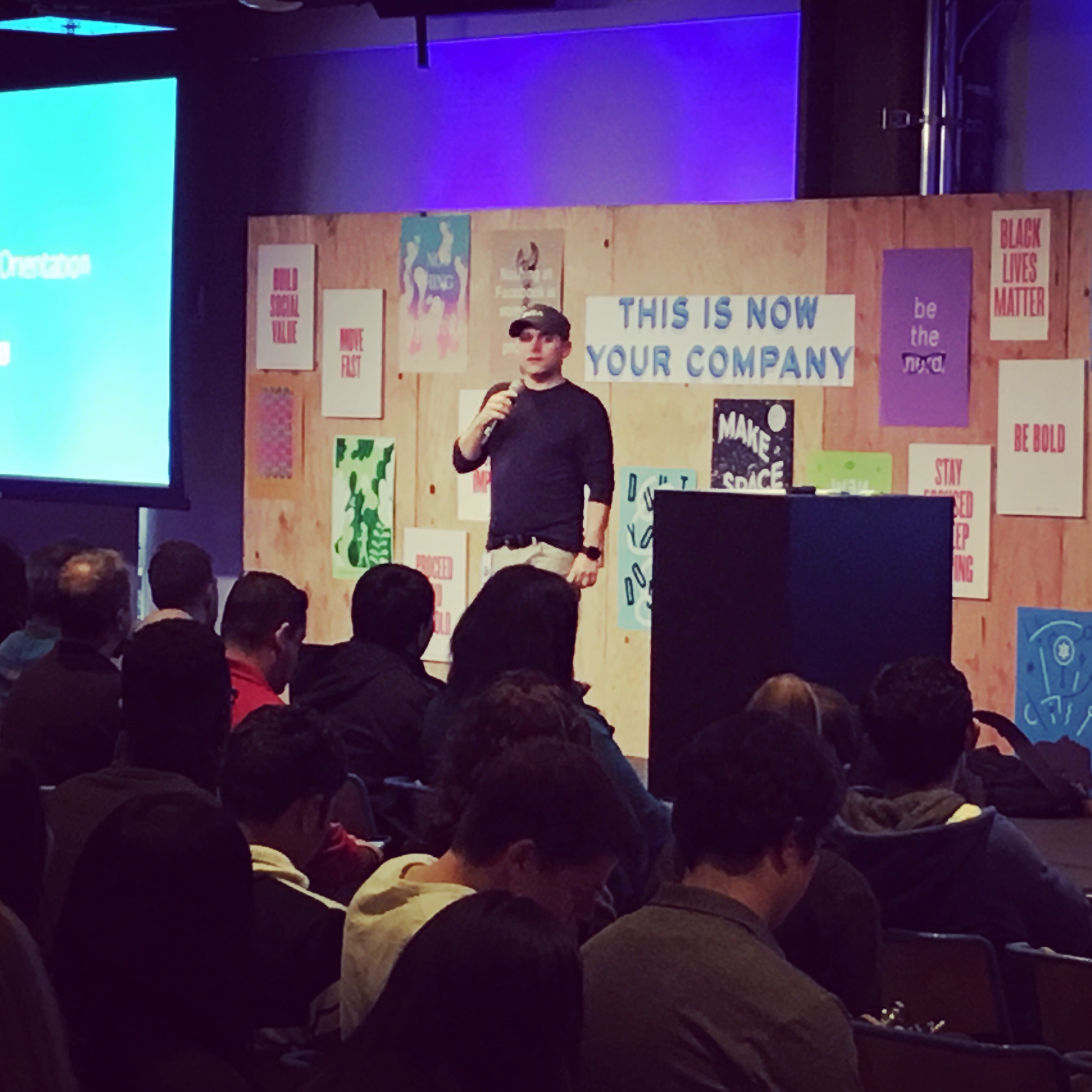Lead Your Career
Mike Rognlien is the founder of Multiple Hats Management, a leadership consultancy. Prior to founding his company, Mike spent fifteen years learning while working at Facebook, as a consultant to Microsoft, and at numerous other companies. In fact, he was one of the founding members of the L&D team at Facebook. After reading his new book, This Is Now Your Company, I reached out to him to continue the conversation.
Your book about the Facebook culture was released right after Facebook was in the news for its questionable privacy practices. The question many may ask now: Is Facebook really a culture to emulate? Why?
It’s a fair question, but I’d start by saying it’s about much more than any one company’s culture – it’s about the individual’s role in their organization’s culture and how they can really own it. That said, I think that every company makes mistakes, and every company is going to face challenges based on real or perceived issues. Being on the outside of the company now I can say that I was really proud of how Mark and other senior leaders from Facebook handled themselves and continue to handle themselves. They apologized, accepted responsibility for mistakes, directly confronted misunderstandings or incorrect assumptions and have already made some pretty sweeping changes to how the platform operates. I’ve done leadership development work for a long time and think that this is what we want leaders and their companies to do when they mess up.
Improve Performance with Mirror Moments
What’s a mirror moment and how can they be used to improve our performance?
One of the things that is consistent in the learning field is the push to reflect – and rightfully so. It’s a powerful development tool that we all have available to us at all times. In a 24/7 news cycle / instant meme-ification culture, I think it’s become even MORE important to do this because we are constantly getting so much outward signal (likes, comments, engagements, etc.) on how others see us that we can forget that it’s really important to know how we see ourselves. In so many programs I’ve developed or led over the years – on hard conversations, on bias, on leadership – much of my time and energy has been getting people to stop looking outside of themselves for approval and validation (or blame when things go wrong) and to instead constantly look inward to understand how what they’re saying and doing is impacting the results they’re generating. We need feedback from other people, absolutely, but we can make that process so much easier if we’re willing to have that first hard or reflective moment with ourselves.
How prevalent is Organizational Stockholm Syndrome? What can be done to reverse it?
I have seen it in every organization I’ve ever worked in – some more than others. Since so much of my career has been in tech—and because there is a common misconception that all tech companies are culturally homogeneous—it’s something I started speaking about regularly at Facebook. I write in the book about how passive-aggressiveness drives me absolutely crazy but, at the same time, I not only tolerated it when it was a cultural norm at previous clients/employers, I participated in it! I’ve never met a person who didn’t have at least 1-2 things – or many more – that they really despised about the way their organizations operated, but with even a little gentle digging (“What role did you play in it, though?”) they quickly realized that even if they’re not actively contributing to it, being a silent bystander is a form of contribution to the problem. As with any problem, the first step is to acknowledge that it exists, and like I had to admit that I sometimes dabbled in behavior that I said I despised (and meant it!), so do we all. Once you do that, especially if you’re willing to share it with the people around you – you’re well on your way. It’s why I told my passive-aggressiveness story to thousands of new Facebook employees – if any of them saw me slipping into old behaviors, I had an army of people ready and willing and able to call me out on it.
Why We Dread Feedback
I love your section on feedback, and you even advocate dropping the dreaded word. Would you share a few of your counterintuitive views on feedback?
Thank you! Yeah, feedback. Most people hate the word; most people hate hearing it – sometimes even when it’s positive – but as one of my favorite authors (Joseph Grenny of Crucial Conversations) has reminded me over the years, the only thing that can generally save us from our own worst performance and results is other people. As I write in the book, I’ve come to the point where I don’t get too wrapped up in whether the feedback I get is positive or negative and instead focus on its utility. Even if I can’t stand the person giving me criticism (or in the case of being an author, from strangers on the internet!) I can look at what he or she is saying and decide that my personal dislike aside, they’ve shared something useful. Focusing on utility also helps us filter out a lot of the useless feedback we sometimes get from people we DO like – empty praise that just flatters our egos or softball critiques that soften hard messages that we’d benefit from hearing. That feedback isn’t any more valuable than mean-spirited criticism from people whose only objectives are to make us feel bad or diminish us; the two are equally un-useful.
Master Emotions
Fear. It’s not covered in most business schools. How does a fear mentality affect your work and what can you do about it?
 I think we’ve become such an emotional society in general that it’s not even just fear anymore; it’s all of the emotions that we have to learn how to experience and feel but then move on from and keep going. I’ve definitely experienced a decent amount of fear in my life and in my career, but one of the things I learned from years of great managers and coaches and through watching leaders who inspire me is to talk through it, let whatever emotion I’m experiencing run its course and then, as we discussed above, be willing to reflect. Scientifically, we know that fears and phobias in general are exaggerated and silly with a little perspective and data thrown in, and instead of saying things like, “I KNOW I AM MORE LIKELY TO DIE BY SHARKNADO THAN A PLANE CRASH, I AM NOT GETTING ON THAT PLANE!” and then letting that unsubstantiated fear drive behavior, I get on the plane. But that plane is a metaphor for lots of things we face in life in and out of our work lives. When I see people being silly about fear, I get silly in return – I will respond to their fear of applying for a promotion or a transfer or a new team or whatever by saying ‘you’re right, you shouldn’t do it, it’ll kill you and I’d miss you when you were gone.’ It’s an unorthodox technique, for sure, but once you can understand that you’re probably not going to expire should you attempt something bold, it gets easier to walk back from that worst-case scenario and focus instead on what the real pros and cons for doing (or not doing) something are and how you can take steps to navigate them without getting too caught up in doomsday scenarios.
I think we’ve become such an emotional society in general that it’s not even just fear anymore; it’s all of the emotions that we have to learn how to experience and feel but then move on from and keep going. I’ve definitely experienced a decent amount of fear in my life and in my career, but one of the things I learned from years of great managers and coaches and through watching leaders who inspire me is to talk through it, let whatever emotion I’m experiencing run its course and then, as we discussed above, be willing to reflect. Scientifically, we know that fears and phobias in general are exaggerated and silly with a little perspective and data thrown in, and instead of saying things like, “I KNOW I AM MORE LIKELY TO DIE BY SHARKNADO THAN A PLANE CRASH, I AM NOT GETTING ON THAT PLANE!” and then letting that unsubstantiated fear drive behavior, I get on the plane. But that plane is a metaphor for lots of things we face in life in and out of our work lives. When I see people being silly about fear, I get silly in return – I will respond to their fear of applying for a promotion or a transfer or a new team or whatever by saying ‘you’re right, you shouldn’t do it, it’ll kill you and I’d miss you when you were gone.’ It’s an unorthodox technique, for sure, but once you can understand that you’re probably not going to expire should you attempt something bold, it gets easier to walk back from that worst-case scenario and focus instead on what the real pros and cons for doing (or not doing) something are and how you can take steps to navigate them without getting too caught up in doomsday scenarios.
The Importance of Leaving Well
Would you share what you learned from Broadway about leaving well?
Oh man – so much. I remember sitting one night with my friend (and fellow author – of Failing Up!) Leslie Odom Jr who had just won a Tony® award for playing Aaron Burr in Hamilton and, a month later, left the show to start his own solo career. He’d just done his first big concert-ish show in San Francisco, and I told him that I was getting ready to move on from Facebook and start MY own thing and would love some words of wisdom, since many people couldn’t fathom why he had walked away from such a juggernaut. In a nutshell, he shared that no matter how great the role or the show or the audience reaction or the publicity, etc. was for any given show, there comes a point where it is… 8 shows a week. And any artist or creator gets to a point where they pass that point where they’ve found substantial new ways of sharing the same story or the same performance and so they move on. That resonated with me deeply – not just because I felt some aspects of my work had become ‘8 shows a week’ but because one of the reasons he felt it was time to go is that he didn’t want to experience his performance suffering. Seinfeld said the same thing when he ended his incredibly successful show in the late 90s: he didn’t want people to say of his show, “Oh yeah, that was really funny two seasons ago.”
When it’s time to go, it’s time to go, and you do yourself and the people and teams around you a significant service when you recognize and acknowledge that it’s time for you to go find a new show to perform in and a new role to tackle and master.
Develop a Leadership Mindset
What characteristics define someone who has the “This is Now Your Company” leadership mindset?
I think someone who is, first and foremost, there for the mission. I don’t care if your mission is feeding people in a restaurant or connecting them on social media or fixing an infrastructure issue in a developing nation – there are seven billion of us on the planet and millions of companies big and small, and if you find a way to do work in an organization that connects their purpose to your reason for being on the planet, ownership is a non-negotiable price of admission. So first you have to know who you are and why you’re here and how you can make that useful to someone/something else. The second is, as I talk about so many times in the book, someone who is a scientist of his / her own behavior and who, like a scientist, is willing to tweak things that either aren’t working or aren’t working well. That’s why so much of the book isn’t about tons of theory but some simple/straightforward basics that are hard as hell to master but disproportionately impactful to outcomes. If you can know and manage and change yourself when necessary – those three things make me want to work with you because you’ll exist in a constant state of curiosity about how what you’re doing internally is impacting things externally. And it’s a mindset I firmly believe you can learn if you’re armed with the right questions.
For more information, see This Is Now Your Company.


